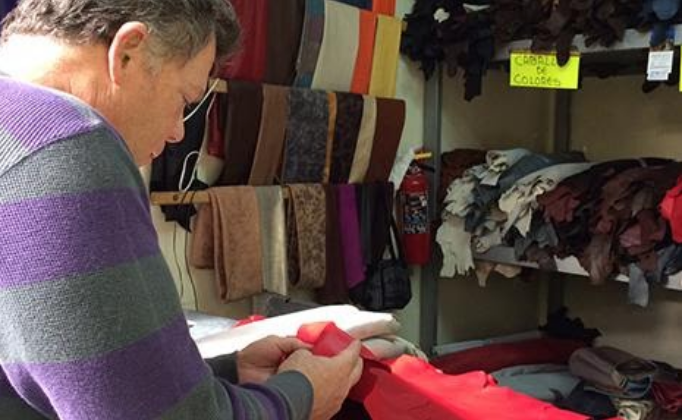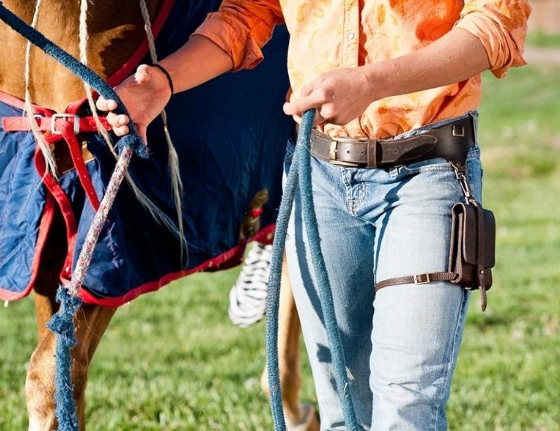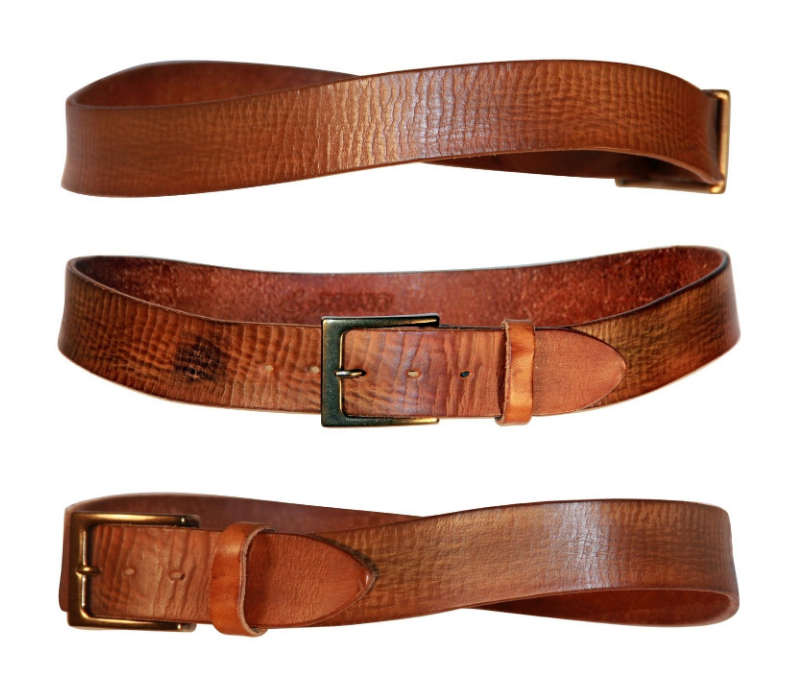Starting a Business From Scratch … Without Investors (Article #1 - Ready, Fire, Aim!)
(This is the story of Embrazio, a leather accessories company in Boulder, Colorado, complete with lessons learned and a few tools and exercises all brought together for your entertainment and hopefully a bit of learning to boot. The story is told in the form of a series of articles by Embrazio founders Scott Schaefer and Stephanie Boyles … who also happen to be married.)
Ready, Fire, Aim! … the story of our start
“You’re in between gigs right now. We’ve worked on tons of projects together over the years in different companies. Why don’t you and I start a business?” About an hour after she’d posed this question to me, my wife Stephanie and I had decided to jump into the leather accessories business. You’d have thought with our extensive business and consulting careers, we’d have been a bit more analytical and strategic about the decision but, screw it, we were just ready to jump in … I guess. Funny, as I think about it, I realize our jumping into business together is very similar to our jumping into marriage together some 32 years ago. Lots of patience and dating and then, boom, one day we just made the leap.

That was 10 years and 10’s of thousands of miles ago and we’re still working hard and having a hell of a lot of fun in the process. Of course, there have been lots of missteps and lessons learned along the way. We’re thinking they might be helpful to other corporate refugees who have a few extra bucks and an itch to scratch around starting their own business. We know we wish we’d have had a better map for the journey but, somehow, we’ve made it to cash flow positive and now have an extensive line of beautiful handmade leather goods carried online and in over 200 higher-end boutiques nationwide. The following is our story about Embrazio, a leather accessories company headquartered in awe-inspiring Boulder, Colorado, as told in a series of first-person accounts/lessons by us, its founders, Stephanie Boyles and Scott Schaefer. We hope you find it fun, interesting, and helpful as you embark upon your upcoming adventure!

Lesson #1 – There is no common starting line … so get started!
If starting our company had been a Mission Impossible assignment, the recording would have sounded something like this:
“Stephanie and Scott, you’re too young and energetic to retire, you get bored easily, you’re not likely to get any great job offers that don’t require you to move or travel all the time, and you love your life and friends in Boulder, Colorado. Your assignment is to figure out something to do professionally in Boulder that won’t risk breaking the bank, will be rewarding psychologically and financially, and won’t screw with Steph’s horseback riding or Scott’s golfing too much. Good luck. This tape will now self-destruct … hope you two don’t!”
We started Embrazio after successful tech/telecom careers spanning the previous 25 years or so. Both of us had worked extensively in new product development. Scott had experience as the CEO of a VC-backed tech company and had spent a couple of years working as co-founder of a start-up consumer goods company after working for 20+ years in large corporations. Stephanie was just winding down her first start-up, a web site and collection of mobile apps targeted at the equestrian market (in-line with her horse obsession). She’d also worked in several top business consulting shops and had started virtual businesses inside a large corporation. So, in our case, we had enough knowledge and experience to be dangerous as well as enough money to get going and withstand a negative cash burn for a while.

Custom Leather Belts & A Leather Phone Holster
We also had an initial product in mind. Stephanie had created a mobile phone app that took Jec Ballou’s very popular “101 Dressage Exercises for Horse & Rider” dressage training book and moved it into a series of diagramed exercises accessible to riders via their cell phones. The question then became, “how can I carry my phone with me while on horseback in a way that is safe, attractive, and convenient?” That led to Stephanie’s second creation, a custom leather belt and holster inspired by the gun holsters of the old west, exchanging old tech for the weapons of today: your cellphone. She got a local leather artisan to prototype the product and, voila, we had something to show to real people to get real feedback.

Honest feedback from real potential customers should be #1 on your list for getting started no matter where you’re starting from. We learned a lot about how to build the cellphone case and how to wear it while riding through product testing. For example: 1) You can’t close the case with a magnetic snap – your phone can fall out while jumping cross-country. 2) You can’t close the case with a buckle because the horse can run off on you while you’re fastening or unfastening the buckle. 3) You need to be able to get your phone in and out of its case with one hand while you hold the reins in the other hand because you can get into serious trouble if you just let go of the reins. We didn’t find out about (or just stubbornly refused to hear about) the larger issue of women not liking the thigh strap attachment until we actually got the product to market.

If We Could Get A Do Over…
Looking back on it now it seems pretty obvious that we could have (should have) started our product line with just curved leather belts as they appeal to a much larger market than cellphone holsters. Instead, since we already had a phone case prototyped, it never really dawned on us that we could put the leather phone case to the side for later development and marketing. This failure to boil down our product to a clearly valued and easy to understand initial offering made our first release much more complex, time consuming, and expensive than it needed to be.

Still We Were Making Great Progress …
At this point we really hadn’t spent much money (maybe a few hundred dollars) and already we had a prototype and real market feedback albeit without the demonstration of an actual purchase quite yet. Lots of start-ups we’ve been involved with over the years, either directly or as advisors/consultants, spend 6 months or more doing market analysis and software or product development when they could much more quickly put a prototype together with duck-tape and bailing wire (as they say) and get reactions from real shoppers immediately. In the software world this is often called fail fast, scrum, spiral development, or other nifty terms but it all depends on a circle of; produce cheaply & quickly --> get customer feedback --> produce again based on the feedback --> get another set of feedback and so on. The same process can work in any industry, hard or soft, and we’ll talk more about the key elements of new product development down the road.

The Good, The Bad, & The Missing …
Fast prototyping is something we did right during the “Get Started” phase. We got a prototype to market very quickly and then listened for guidance from real customers. What we didn’t listen carefully for were opportunities to narrow and simplify our initial product offering. What we also didn’t do was think much about the economics of reaching the larger market or what it would take to get the business to cash flow breakeven. This mistake was particularly egregious as we were working in an area where we had little to no experience or knowledge. Even worse, we had both done lots of business cases and had financially analyzed many businesses during our tech/consulting careers. Let’s just say WE KNEW BETTER! Please stay tuned in for our next article where we start to tackle the business side of starting a business from scratch without investors!Summary of Article #1:
- START. You’re in a unique starting position and there is no guaranteed cookbook that works for everyone. Just get started, build some momentum, learn and adapt.
- LISTEN. Get feedback as soon as possible from real potential customers. Build a prototype, draw pictures, make a slide show, or whatever you can do that will convey your idea as fast and as clearly as you can to potential customers without spending a ton of time or money. Listen to feedback with an ear toward what is wrong, not just for validation that you’re right.
- SIMPLIFY. Think hard about your answer to this question: What is the simplest, fastest, and least costly product/service offer I can make to get into the market and start getting real feedback and real revenue?
Quick Starting Line Checklist:
- What value am I creating and for whom? You’d be surprised how many entrepreneurs don’t have clarity on this most basic question. They’ll say things like “everyone could use this” or “I can see how we could sell this to the healthcare industry, the defense industry, the software industry.” Those broad claims may be true but who is the first person in the first industry that is going to buy this and then tell their friends and associates about it who are in the same industry so it will grow organically from day one.
- What is the fastest & cheapest way to get something tangible in front of potential buyers so I can get real feedback? There are lots of ways to do this and you may want to try several as your thinking matures. A set of power point slides might be a fast and early way to get feedback. We chose to use a local leather maker that we knew would be too limited and expensive for production runs but could make and modify early versions of our product until we honed in on something close to the final specification.
- Who will give me honest and direct feedback? You don’t want to go to your spouse or your mom and say what do you think? They love you and won’t want to hurt your feelings or “tell you your baby is ugly.” You don’t want a negative person who will be overly critical either. You likely want a set of folks that play off each other’s comments and tell you like it is. We asked friends at a coffee shop initially and then pulled together small focus groups of people we knew were straight shooters and strongly encourage all to tell us both the good and the bad.
